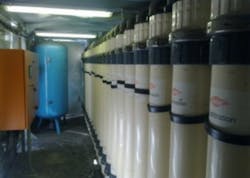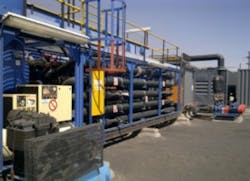Reverse osmosis aids wastewater reuse in South African coal mine
Coal is South Africa’s primary resource for generating energy. It represents more than 80 percent of the country’s energy supply. During power production, coal is burned to generate steam. Steam is then used to drive turbines that generate electricity. Water is an integral component in this process because it is used in steam production, to extract and wash coal, and to cool the steam to produce electricity.1
For countries in which water resources are limited or scarce, as they are in South Africa, water reuse schemes are implemented to reduce the stress on freshwater assets and promote an environmentally contained process. Following suit, a local coal mine treats its wastewater from mining operations for reuse and transports it to the nearby power station to be used as make up water in the cooling system operations.
A new UF and RO treatment system
Because conventional sand filters and other ultrafiltration (UF) technologies used to treat the mining wastewater were found to be ineffective, the coal mine turned to a manufacturer of ultrafiltration (UF) technology as a pretreatment to reverse osmosis (RO), to effectively recover wastewater.
The installed UF technology. All graphics and photos courtesy of Dow Water & Process Solutions.
To remove suspended and dissolved materials from the wastewater stream, the UF technology manufacturer collaborated with a local original equipment manufacturer to rapidly deploy a modular containerized system.
The modular treatment system
The UF membrane technology ultimately had increased advantages when compared to traditional sand filters during pretreatment, including the removal of particles, suspended solids and microorganisms from the wastewater.
Figure 1. The new filtration system (left) better controlled when compared to traditional sand filters (right).
Most raw water contains particulates — such as silt, colloids and bacteria — which can negatively impact the performance and economics of downstream operations and demineralization equipment. These contaminants can be effectively removed using filtration technology to facilitate continued and consistent performance of boiler feed and water treatment systems, and reduced environmental impact (see Figure 2). This removal decreases the need for downstream RO membrane cleaning.
Figure 2. Diagram of the water treatment system
After the coal mine’s wastewater is treated with UF and RO, the recycled water is transported to a nearby power station, where it is further demineralized with an ion exchange resin technology, and used as boiler make-up water in the cooling system.
References
- Union of Concerned Scientists. "How it Works: Water for Coal." http://www.ucsusa.org/clean_energy/our-energy-choices/energy-and-water-use/water-energy-electricity-coal.html
Dylan Hunter is an account manager at Dow Industrial Solutions (South Africa), and can be reached at [email protected].
Etienne Du Toit is a key account manager at Dow Water & Process Solutions (South Africa), and can be reached at [email protected].
Dow Water & Process Solutions manufactures sustainable separation and purification technology including ion exchange resins, RO membranes, UF membranes, fine particle filters and electrodeionization products for use in industrial and municipal water, industrial processes, pharmaceuticals, power, oil and gas, residential water and waste, and water reuse. For more information, visit dowwaterandprocess.com.




